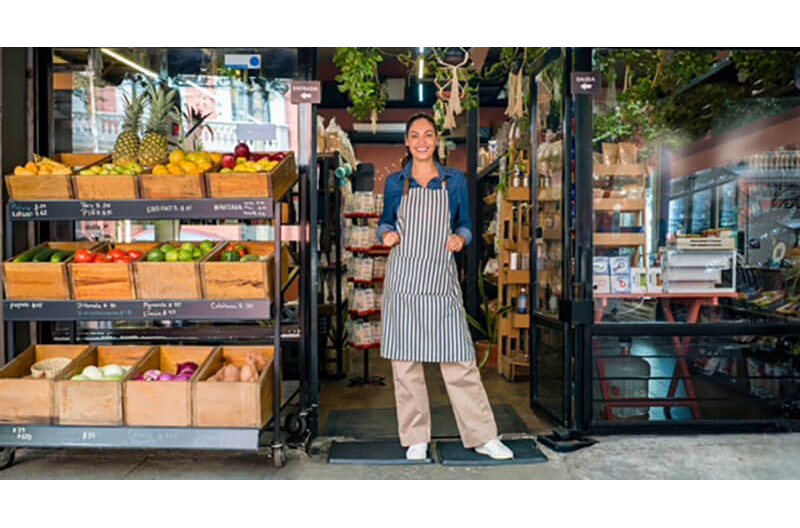Independent food retailers across the United States have an opportunity to fund store upgrades that reduce operational costs, improve profits and enhance sustainability. Administered by the U.S. Department of Agriculture, the Rural Energy for America Program (REAP) provides grants to rural small businesses for energy efficiency improvements (such as HVAC, lighting, and refrigeration) and renewable energy systems (such as solar).
The recently enacted Inflation Reduction Act added $1.7 billion to REAP’s budget, enabling the program to increase its funding cap from 25 percent of project costs to 50 percent. Maximum grants for energy efficiency are $500,000, while renewable energy grants go up to $1 million. Loan guarantees of up to 75 percent of project costs are also available.
This level of funding redefines what’s possible for independent grocery stores, which are typically challenged to implement capital-intensive energy upgrades due to limited budgets and tight margins.
“REAP is an ideal opportunity for independent grocers to reduce operational costs and future-proof their business,” said John Ross, CEO of the Independent Grocers Alliance (IGA), the world’s largest group of independent grocery retailers. “With so many rural independent stores being run by second-, third- or even fourth-generation families, they increasingly face the challenge of updating equipment to be more energy efficient. This program is a no-brainer for rural grocers: upgrade your store with supplemental funding.”
The final REAP application deadline for a 50-percent grant is the end of September.
 Applications are reviewed in quarterly cohorts. Each state scores and ranks its applicants, and then awards funds until that quarter’s funding pool has been used. There are some additional federally shared funds that can be awarded at a state coordinator’s discretion.
Applications are reviewed in quarterly cohorts. Each state scores and ranks its applicants, and then awards funds until that quarter’s funding pool has been used. There are some additional federally shared funds that can be awarded at a state coordinator’s discretion.
Starting in October, REAP grants will still be available, but the grant cap is expected to go back down to 25 percent.
Each state has several technical assistance providers for this grant program, who can assist with various steps of an application. Ratio Institute is an industry-specific provider, with experience helping food retailers apply for and implement projects with these funds.
To take advantage of the current funding level, contact Ratio Institute no later than mid-July. It’s a complex application process, and it takes time to gather the necessary information to apply.
Ratio Institute will guide applicants through the process from start to finish, provide comprehensive technical support and handle most of the work required to complete the application.
REAP can help independent grocers deploy major upgrades. With a $500,000 grant, a small store could replace most of its refrigerated cases or overhaul its HVAC system.
For refrigeration projects, grants can also cover related electrical work as well as the use of more sustainable refrigerants to ensure compliance with federal hydrofluorocarbon gas phase-down requirements. Many independent stores have refrigeration equipment that is 20-30 years old. By upgrading this equipment, they can save tens of thousands of dollars per year on operating costs.
[RELATED: Benchmarking And Upgrades Via The USDA REAP Grant]
Application process
For energy efficiency projects, the most important factor in getting funded is demonstrating that new equipment will yield significant energy savings by replacing inefficient equipment. For renewable energy projects, the key is to demonstrate significant annual electricity generation and provide documentation of site control.
For both types of projects, USDA is also looking for short payback periods and environmental benefits such as water conservation and reduced greenhouse gas emissions.
The first step is to determine if you’re eligible for the grant. Applicants need to be located in a rural area and be a small business with a net annual revenue of $5 million or less. Fill out this form to determine eligibility.
For grocers that are eligible and want application support from Ratio Institute, the next step is to complete a 30-minute store assessment survey and provide 12 months of utility bills. The survey includes questions about the square footage of the store, the type and amount of equipment (such as refrigerated cases and lighting) and operational practices (such as procedures for turning off heated wrapping machines).
Based on the survey and utility bills, Ratio Institute provides a report detailing the existing operational practices and equipment along with recommendations for best practices and equipment upgrades that REAP could potentially fund. Each recommendation includes estimates for annual cost savings and greenhouse gas emissions reductions.
Cost savings come from lower energy usage, lower refrigerant leakage and reduced maintenance costs. This will serve as the energy audit required for the REAP application. Locations that are not eligible for a REAP grant can still find significant areas of savings by completing this step.
After identifying upgrades to be supported by REAP, the grocer will need to get quotes from preferred vendors for their costs. The most common delay in the application process is getting these quotes. It can take weeks or even months to find a competitive quote, especially for stores in more remote areas.
Travel and overtime costs associated with a project are also eligible for the grant match. Grocers who are interested in applying to REAP are encouraged to start talking with their vendors as soon as possible. Ask them how long it would take to order and install the equipment.
Ratio Institute will draft and submit the REAP application, which includes a detailed technical narrative about the upgrades, related expenses, operational benefits, projected cost savings, environmental benefits, past and projected financial statements and a detailed project budget. USDA typically takes three to six months to review applications.
Any costs incurred before the final application is submitted will not be eligible for reimbursement; however, some project costs incurred between the time of submission and notification of award are eligible.
Ratio Institute will work closely with grocers to ensure their projects move forward while keeping costs eligible for the reimbursement.
USDA releases the grant funds after the upgrades are completed, which means stores will need to finance the project to completion before reimbursement. The application requires proof of matching funds. Some stores plan to pay for the upgrades by themselves or have worked out financing arrangements with their vendors. Others are securing loans from their banks.
When USDA pays the grant, stores can refinance the loan in a short period, leaving 50 percent to be repaid.

